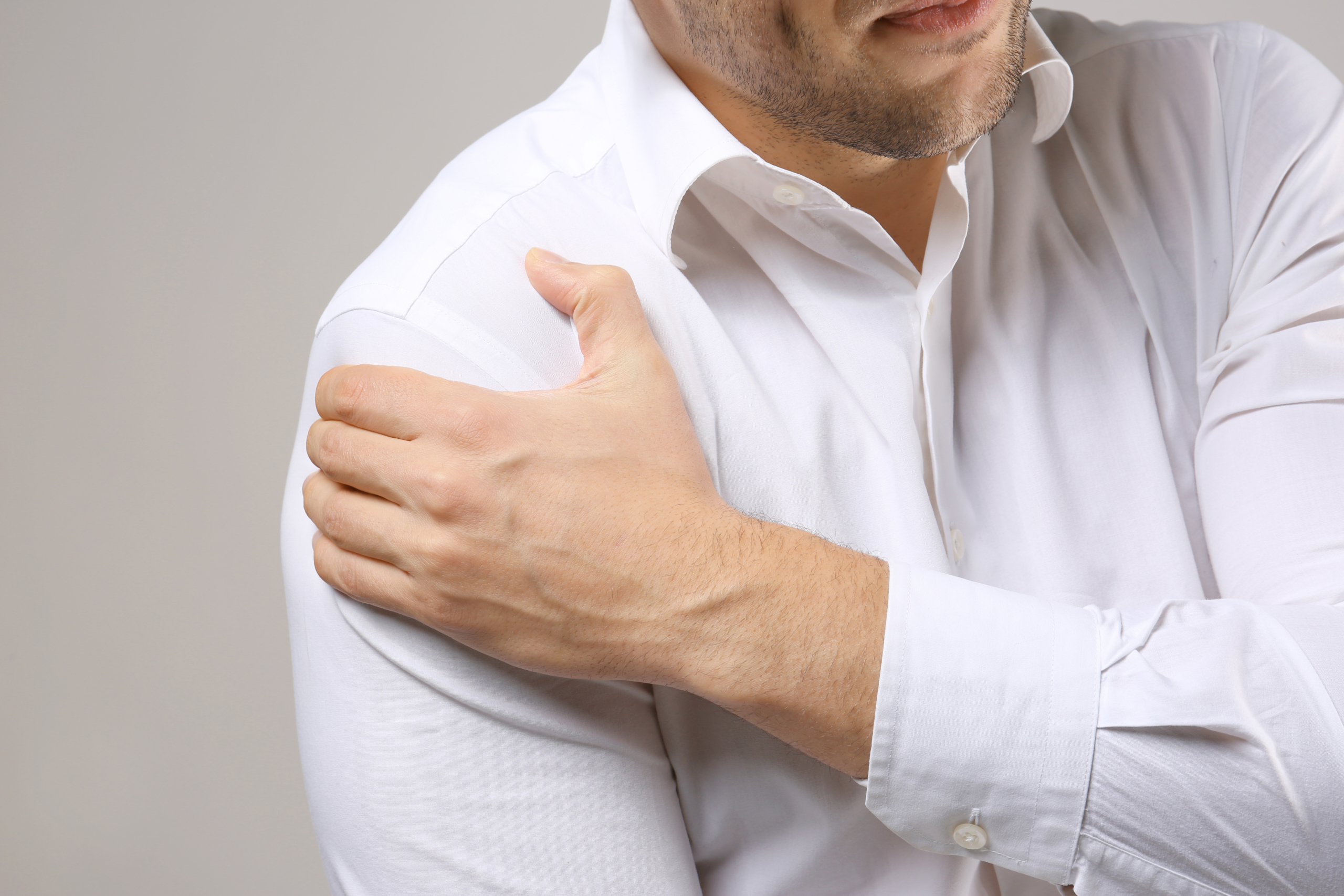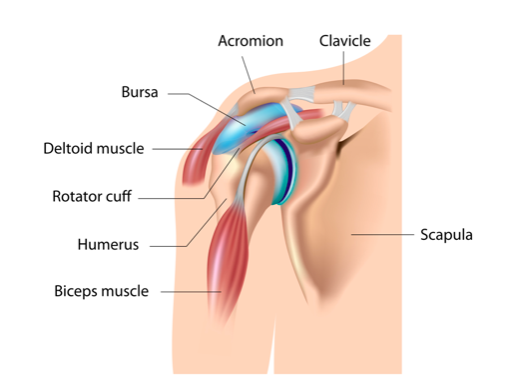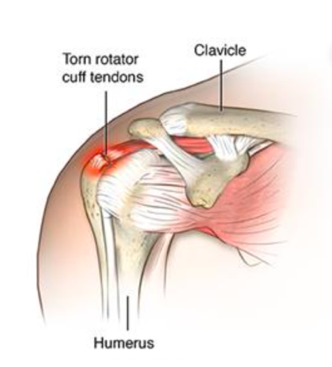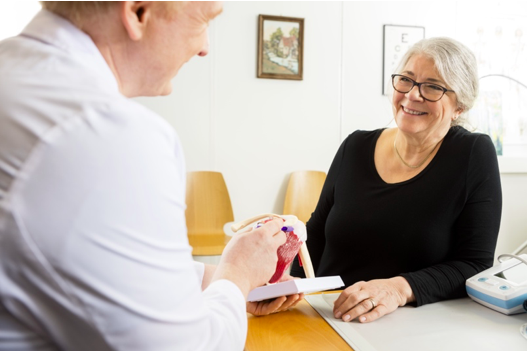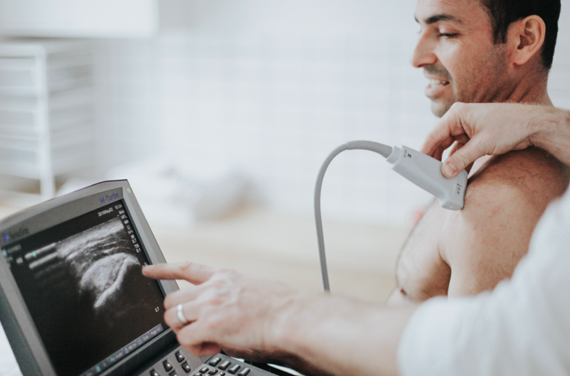Shoulder pain – could it be your rotator cuff?
The shoulder joint is made up of the ball (humeral head) and the socket (glenoid). The rotator cuff consists of four tendons that are positioned around the ball (humeral head) – like a cuff. The rotator cuff consists of four tendons; supraspinatus, subscapularis, infraspinatus and teres minor. The role of the rotator cuff is to provide stability to the shoulder joint and help to produce movement such as lifting and rotating the arm. The most common tendon injured is the supraspinatus tendon.
Rotator cuff pain is normally caused by swelling of the tendon (tendinopathy/tendinitis) or a tendon tear. It is a very common injury that we see in clinic and can be a very painful and debilitating condition. It is most common between the ages of 40-60 years old.
Located on top of the rotator cuff is the bursa, specifically the sub-acromial bursa (see image above). This is a very pain-sensitive structure and is often involved in rotator cuff pain. If the bursa is inflamed it is called a bursitis and can be very painful.
Patients with rotator cuff symptoms and/or sub-acromial bursitis present with pain located on the side of the upper arm (see first image) and weakness in the shoulder. The pain is often achy with an occasional sharp pain when patients perform certain movements. Patients often have difficulty lifting their arm, putting their hand behind their back, during overhead activities such as playing tennis and lifting weights in the gym.
Who gets rotator cuff pain and what causes it?
Rotator cuff pain can be due to:
- Rotator cuff tendinitis/tendinopathy: in young athletes and middle-aged people who take part in repetitive overhead activities such as tennis, swimming and weightlifting. However, it also occurs in more sedentary individuals
- Certain chronic diseases such as diabetes and obesity are also associated with rotator cuff tendinitis/tendinopathy.
- Rotator cuff tendinitis/tendinopathy occurs when the rotator cuff tendons become swollen and painful. The pain normally occurs due to too much activity too quickly.
- For example, when returning to the gym or sport after a prolonged period of inactivity. Rotator cuff tendinopathy is often associated with subacromial bursitis. It often occurs for no apparent reason i.e. no accident or trauma, such as a fall.
- Rotator cuff tear: One of the main risk factors for rotator cuff tears is age i.e. as we get older, we are more likely to have rotator cuff pain in our shoulder. There is a significant increase in the number of tears once you are over 50.
Interestingly, the intensity of the pain does not necessarily correlate with the severity of the injury/size of the tear. Small tears and even some bigger tears are quite common as we get older but do not cause any pain or weakness.
Rotator cuff tears are categorised by the size and location of the tear. They can be a partial tear or a full tear of the tendon. Suprapinatus is the most common tendon to tear in the shoulder (see below image).
The management of a rotator cuff tear varies from person to person.
It is often dependent on the age of the patient, why the pain started in the first place e.g. traumatic (occurred due to a specific trigger/incident) or atraumatic (no apparent trigger) and the activity levels of the patient.
- Calcific tendinopathy (also known as calcific tendinitis): We are not sure why some people develop bony deposits in the rotator cuff tendons. Some people have calcium in their tendon, but it doesn’t cause any pain. It can sometimes be related to some metabolic diseases such as abnormal thyroid gland activity and diabetes. It can affect anyone but is more common in active people who carry out prolonged overhead activity or exercise such as tennis players or painters.
Calcific tendinopathy is when there are bony deposits (calcium/calcification) in the rotator cuff tendon. This normally occurs in the supraspinatus and infraspinatus tendon. We do not know what causes the bone deposits to develop in the tendon. It can cause a very rapid onset of severe pain, particularly at night and a significant restriction in shoulder movement. If this occurs, it is known as acute calcific tendinitis.
How do you diagnose rotator cuff pain?
The diagnosis of rotator cuff pain is a “clinical diagnosis” which means that your physiotherapist can diagnose it during your initial assessment. The symptoms of rotator cuff pain are:
- Achy pain on the outside of the shoulder that can travel towards the elbow
- Sharp pain when you move your arm quickly, above your head or behind your back
- A feeling of weakness when you lift something up
- Inability to move your shoulder fully
- Pain is often worse at night particularly if you sleep on the shoulder
During your initial assessment, your physiotherapist will also carry out some specific tests of your shoulder to gain more information about your presentation.
There are many factors that must be considered and these will be assessed if your physiotherapist feels they may be relevant to your presentation:
- Strength of your rotator cuff muscles
- Strength and stability of your scapula muscles
- Mobility of your middle back (thoracic spine) and your neck (cervical spine)
- Technique in the gym or during sporting activities
From your assessment, your physiotherapist will be able to tell you if you have rotator cuff pain.
To definitively diagnose tendinopathy, tear or calcific tendinopathy you will require a diagnostic ultrasound or an MRI scan of the shoulder. These scans show the inside of your shoulder and look specifically at the rotator cuff.
At Complete Physio, some of our physiotherapists are also qualified musculoskeletal sonographers and will perform a diagnostic ultrasound scan on your first appointment. If you feel you require an ultrasound scan before commencing physiotherapy then please mention this to our reception team when making an appointment. We do not charge extra for the diagnostic ultrasound scan.
What can you do to help shoulder pain?
The vast majority of rotator cuff issues resolve with physiotherapy
- Rotator cuff tendinitis/tendinopathy: This is a very common issue and essentially resolves with a course of physiotherapy treatment. Your Physiotherapy management may involve:
-
- Hands-on treatment to:
- Release “tight and overactive” muscles
- Improve the mobility of the shoulder joint and surrounding structures e.g. the thoracic spine (mid-back)
- Improve the recruitment and muscle patterning of the shoulder muscle rehabilitation exercises to address the:
- Rehabilitation exercises to address the:
- strength of the rotator cuff and surrounding muscles
- stability of the scapula (shoulder blade)
- mobility of the spine – particularly the neck (cervical spine) and mid-back (thoracic spine)
- Hands-on treatment to:
It is well documented that tendinopathy requires a period of 6-12 weeks of strengthening exercise. If the pain continues after this time or you are unable to carry out the exercises due to pain then we would recommend you consider an ultrasound-guided injection.
- Rotator cuff tear: Approximately 80-90% of rotator cuff tears improve with physiotherapy alone and do not require surgery (Ainsworth et al, 2016). The treatment will be similar to the programme outlined above for rotator cuff tendinopathy/tendinitis. There is good evidence to support that even if the tear does not heal, you can still have no pain, full range of movement and full function of the shoulder. Remember most people only have one tear in one tendon and we have three other tendons that can work to compensate!
If the pain:- is getting worse
- waking you at night
- preventing you from engaging in your physiotherapy exercises
we would strongly suggest considering an ultrasound-guided steroid injection for the pain.
Should you have surgery for a rotator cuff tear?
The simple answer is no. Most patients do not require surgery for a rotator cuff tear. As mentioned earlier, many people have a rotator cuff tear (even full-thickness/large tears) but have no pain and maintain full function. The prevalence of asymptomatic rotator tears increases significantly with age. Interestingly, over the age of 60, there are as many people with asymptomatic (pain-free) tears as there are with symptomatic (painful) tears (Lawrence et al, 2019).
However, there is one group of patients that may require a surgical opinion.
If you have developed acute shoulder pain due to a fall or injury, we recommend that you have an ultrasound scan to confirm the diagnosis. If there is a full-thickness i.e. a large rotator cuff tear, then it may be appropriate to see an orthopaedic consultant for an opinion. Your physiotherapist can refer you if required.
- Calcific tendinopathy (also known as calcific tendinitis):
If you have been diagnosed with calcific deposits/calcification within the tendon and the pain is not improving with modification of activity and physiotherapy you have two options.1
1
11/ Shockwave therapy to breakdown the calcification and to encourage the body to absorb the deposits. This requires a minimum of 3 sessions one week apart, but you may require more depending on the amount of calcification.
1
2/ Barbotage/Lavage– is an effective injection procedure which we have been using for many years for calcific tendinopathy. It involves breaking down and aspirating (removing) the calcification through a needle using ultrasound guidance and can avoid the need for surgery.
1
In some cases, we are unable to remove all the calcification and/or your pain continues. In these cases, you may require a surgical opinion. We work with the UK’s leading shoulder surgeons and your physiotherapist will be able to make a referral if required.
Do’s and Don’ts for rotator cuff pain
DO:
- Keep your shoulder moving as much as the pain allows but modify or stop the activities that specifically aggravate your pain
- Carry out your physiotherapy exercises regularly
- If you are struggling to sleep consider an ultrasound-guided steroid injection
DON’T:
- Rush to have surgery unless you have had a specific fall or injury – most rotator cuff injuries do not require surgery
- Continue to do the same activities if your pain is getting worse, i.e. more frequent and/or more intense
- Suffer in silence. We are here to help!
If you are experiencing any of the above symptoms, or have been diagnosed with rotator cuff related pain and would like to see one of our expert physiotherapists please call 0207 482 3875 or email info@complete-physio.co.uk. If you would like to speak to a specialist before booking, then please send us an email with your details and we will call you back.
References
Ainsworth, R., 2016. Physiotherapy rehabilitation in patients with massive, irreparable rotator cuff tears. Musculoskeletal care, 4(3), pp.140-151.
Lawrence, R.L., Moutzouros, V. and Bey, M.J., 2019. Asymptomatic Rotator Cuff Tears. JBJS reviews, 7(6), p.e9.
Don’t let pain hold you back, book now!


